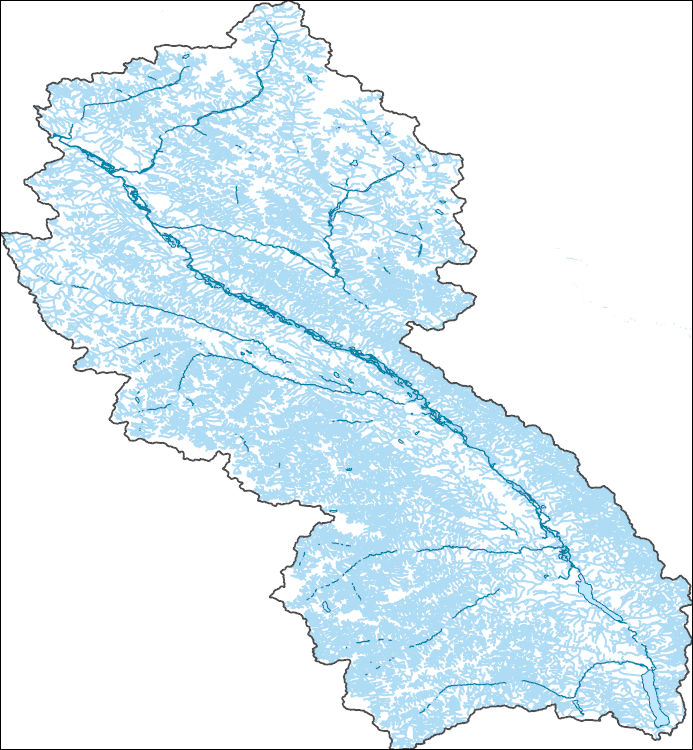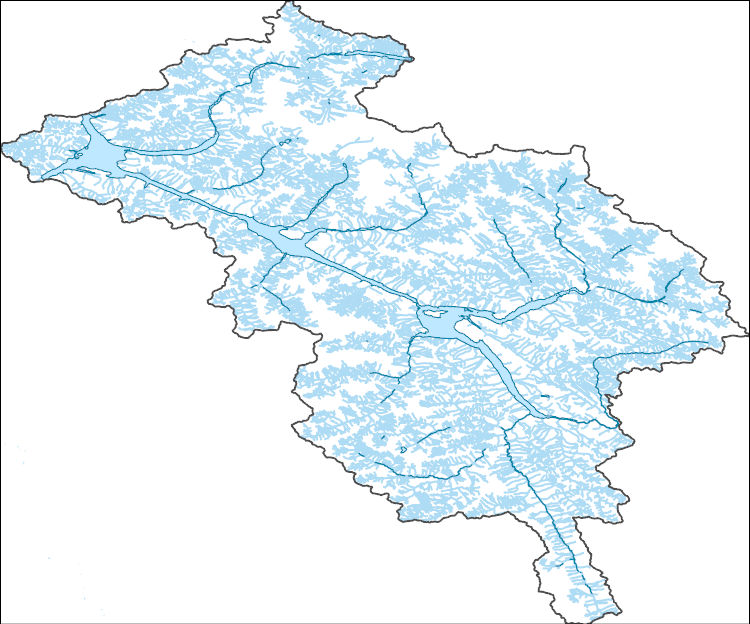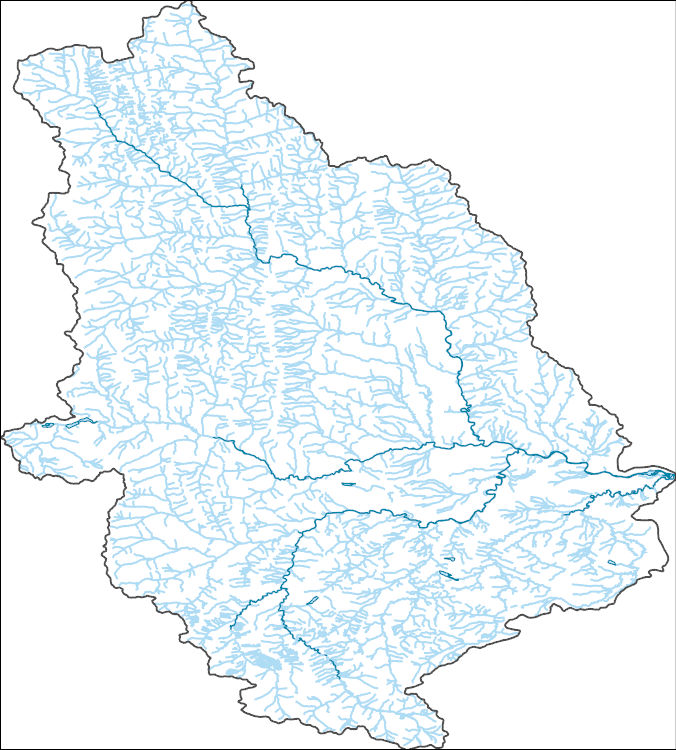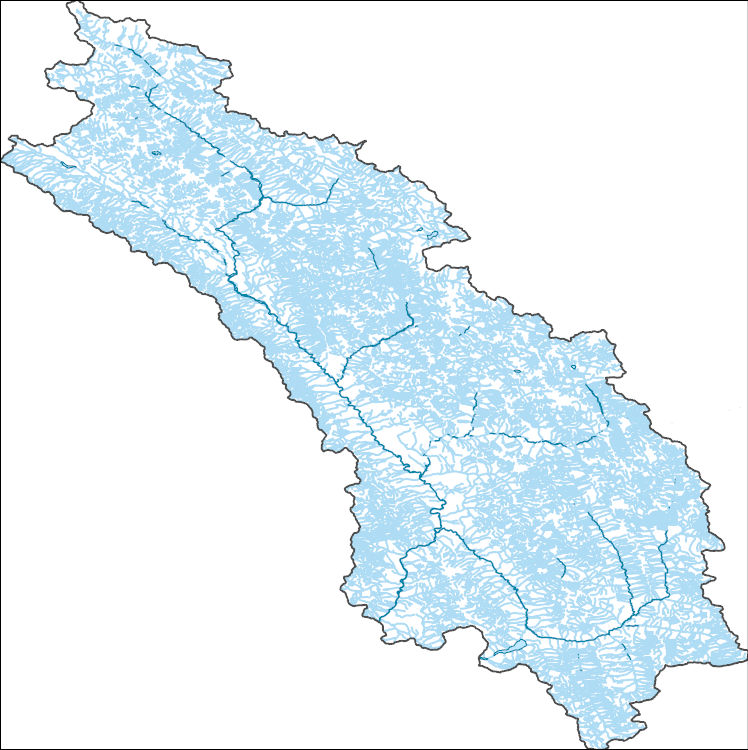Filters: Tags: Alberta (X) > Date Range: {"choice":"year"} (X)
77 results (17ms)|
Filters
Date Types (for Date Range)
Types
Contacts
Categories Tag Types
|

The National Hydrography Dataset (NHD) is a feature-based database that interconnects and uniquely identifies the stream segments or reaches that make up the nation's surface water drainage system. NHD data was originally developed at 1:100,000-scale and exists at that scale for the whole country. This high-resolution NHD, generally developed at 1:24,000/1:12,000 scale, adds detail to the original 1:100,000-scale NHD. (Data for Alaska, Puerto Rico and the Virgin Islands was developed at high-resolution, not 1:100,000 scale.) Local resolution NHD is being developed where partners and data exist. The NHD contains reach codes for networked features, flow direction, names, and centerline representations for areal water...
For the past six years, the Bureau of Reclamation (BOR) has funded the USGS to study fish responses to restoration efforts and to construct a model relating stream habitat with fish population dynamics in the Methow River Basin, a tributary of the Columbia River. In the proposed study, we will use fish growth, distribution and movement (USGS data), foodweb data (Idaho State University), river flow (BOR data that we will expand) and water temperature data (from numerous agencies) to develop spatially-explicit bioenergetics models to assess effects of climate change on the viability of resident salmonid populations based on models being developed by USGS. The bioenergetics models will integrate such things as climate-change...
Categories: Data,
Project;
Types: Map Service,
OGC WFS Layer,
OGC WMS Layer,
OGC WMS Service;
Tags: Alberta,
British Columbia,
Bull Trout,
Climate Change,
Climate Change,
The GNLCC Multi-dimensional Synthesis is a synthesis of existing information in four categories to promote a common understanding of situation, existing information and information gaps, as well as providing an index of programmatic, resource and other climate and landscape related information for GNLCC. The synthesis includes: the GNLCC Resource Directory (organizations and initiatives); climate and ecological response (what does existing and projected climate information say and what are expected ecological effects); and monitoring (who is monitoring what).FY2011Objectives:Provide a Framework from which to organize the various monitoring and evaluation efforts. Included are key monitoring and evaluation questions...
Categories: Data,
Project;
Types: Map Service,
OGC WFS Layer,
OGC WMS Layer,
OGC WMS Service;
Tags: Alberta,
British Columbia,
CO-2,
CO-3,
CO-3,
We propose a collaborative project with the USGS, Wyoming State Climate Office, USFWS, USFS, and the NPS whereby we will assemble and maintain long-term records of climate from key stations in and around the Great Northern LCC and subject these records to a rigorous series of QA/QC procedures. Where appropriate we will use best available practices to infill missing data, and we will develop station histories (e.g., details of station moves, instrumentation changes, etc.) as a context for interpreting these records. We will then rigorously analyze patterns of long-term (50-100 years) variability and trends in these datasets, and provide summaries designed to meet the needs of non-climate specialists working in the...
Categories: Data,
Project;
Types: Map Service,
OGC WFS Layer,
OGC WMS Layer,
OGC WMS Service;
Tags: Alberta,
British Columbia,
CO-2,
CO-3,
CO-3,
The Canadian portion of the Crown of the Continent (CCoC) ecosystem has been identified as crucial for wolverines north of the US border to rescue or supply individuals and genes through dispersal to the highly fragmented population in the northern US Rocky Mountains. Highway 3, motorized recreation, and a growing resource extraction industry, however, increasingly fragment this critical landscape. This project will capitalize on multi-year wolverine occupancy and genetic data collected noninvasively in a >40,000 km2 area encompassing the core protected areas of the central Canadian Rocky Mountains to the north; and Glacier-Waterton Lakes National Park complex in the south. Our goal is to obtain spatially-explicit...
Categories: Data,
Project;
Types: Map Service,
OGC WFS Layer,
OGC WMS Layer,
OGC WMS Service;
Tags: Alberta,
Alpine,
Applications and Tools,
British Columbia,
Climate Change,
This dataset contains a seamless 1:1,000,000 scale British Columbia, Alberta and Montana lakes layer.
Categories: Data;
Types: Downloadable,
Map Service,
OGC WFS Layer,
OGC WMS Layer,
Shapefile;
Tags: 1:1 000 000,
1:1 000 000,
Alberta,
Alberta,
British Columbia,
Climate change over the past century has altered vegetation community composition and species distributions across rangelands in the western United States. The scale and magnitude of climatic influences are largely unknown. We used fractional component cover data for rangeland functional groups and weather data from the 1985 to 2023 reference period in conjunction with soils and topography data to develop empirical models describing the spatio-temporal variation in component cover. To investigate the ramifications of future change across the western US, we extended models based on historical relationships over the reference period to model landscape effects based on future weather conditions from two emissions scenarios...
Wildlife species face threats from climate and land use change, which may exacerbate how extreme climatic events influence population persistence and biodiversity. Migratory waterbirds are especially vulnerable to hydrological drought via reduced availability of surface water habitats. We assessed how whooping cranes, an endangered species in the U.S. and Canada, modified habitat use and migration strategies during drought to understand this species’ resilience to changing conditions and adaptive capacity. The data included 8,555 night-roost sites used by 145 cranes, 2010–2022, under non-drought conditions, moderate drought, and extreme drought conditions.

The National Hydrography Dataset (NHD) is a feature-based database that interconnects and uniquely identifies the stream segments or reaches that make up the nation's surface water drainage system. NHD data was originally developed at 1:100,000-scale and exists at that scale for the whole country. This high-resolution NHD, generally developed at 1:24,000/1:12,000 scale, adds detail to the original 1:100,000-scale NHD. (Data for Alaska, Puerto Rico and the Virgin Islands was developed at high-resolution, not 1:100,000 scale.) Local resolution NHD is being developed where partners and data exist. The NHD contains reach codes for networked features, flow direction, names, and centerline representations for areal water...
This workshop introduced and demonstrated key concepts and a series of software tools, whichallow managers, biologists, and conservationists to efficiently evaluate predictors of wildlife space-use and generate spatial models based on that analysis.Specific content of the workshop: Access to free or low-cost remote sensing information on vegetation, climate, habitat metrics, disturbance, etc., in a useable format, including covariate datasets currently available or under development by the NASA Terrestrial Observation and Prediction System (TOPS) Explanation of how this information is derived, created, integrated, validated and matched with species data sets prior to analysis Demonstration of user-friendly computer...
Categories: Data,
Project;
Types: Map Service,
OGC WFS Layer,
OGC WMS Layer,
OGC WMS Service;
Tags: Academics & scientific researchers,
Alberta,
British Columbia,
CO-2,
CO-3,
Defenders staff, contractors and Great Northern Landscape Conservation Cooperative partners will build a portal on the Conservation Registry to visualize landscape scale plans and conservation projects that address the priorities of the program. The portal will integrate with GN LCCs existing project management tool, LC Map, to spatially display plans within the geographic area of the LCC, provide information about the plans, and link to planning documents. services and/or data imports will be programmed to facilitate efficient transfer of project data from LC Map and other agencies and organizations into the Registry. FY2012Objectives: Coordination with Heart of the Rockies (HotR) staff to identify focal area,...
Categories: Data,
Project;
Types: Map Service,
OGC WFS Layer,
OGC WMS Layer,
OGC WMS Service;
Tags: Academics & scientific researchers,
Alberta,
British Columbia,
Climate Change,
Connectivity,

The National Hydrography Dataset (NHD) is a feature-based database that interconnects and uniquely identifies the stream segments or reaches that make up the nation's surface water drainage system. NHD data was originally developed at 1:100,000-scale and exists at that scale for the whole country. This high-resolution NHD, generally developed at 1:24,000/1:12,000 scale, adds detail to the original 1:100,000-scale NHD. (Data for Alaska, Puerto Rico and the Virgin Islands was developed at high-resolution, not 1:100,000 scale.) Local resolution NHD is being developed where partners and data exist. The NHD contains reach codes for networked features, flow direction, names, and centerline representations for areal water...

The National Hydrography Dataset (NHD) is a feature-based database that interconnects and uniquely identifies the stream segments or reaches that make up the nation's surface water drainage system. NHD data was originally developed at 1:100,000-scale and exists at that scale for the whole country. This high-resolution NHD, generally developed at 1:24,000/1:12,000 scale, adds detail to the original 1:100,000-scale NHD. (Data for Alaska, Puerto Rico and the Virgin Islands was developed at high-resolution, not 1:100,000 scale.) Local resolution NHD is being developed where partners and data exist. The NHD contains reach codes for networked features, flow direction, names, and centerline representations for areal water...
The RCMAP (Rangeland Condition Monitoring Assessment and Projection) dataset quantifies the percent cover of rangeland components across western North America using Landsat imagery from 1985-2023. The RCMAP product suite consists of ten fractional components: annual herbaceous, bare ground, herbaceous, litter, non-sagebrush shrub, perennial herbaceous, sagebrush, shrub, tree, and shrub height in addition to the temporal trends of each component. Several enhancements were made to the RCMAP process relative to prior generations. First, high-resolution training was revised using an improved neural-net classifier and modelling approach. These data serve as foundation to the RCMAP approach. The training database was...
The RCMAP (Rangeland Condition Monitoring Assessment and Projection) dataset quantifies the percent cover of rangeland components across western North America using Landsat imagery from 1985-2023. The RCMAP product suite consists of ten fractional components: annual herbaceous, bare ground, herbaceous, litter, non-sagebrush shrub, perennial herbaceous, sagebrush, shrub, tree, and shrub height in addition to the temporal trends of each component. Several enhancements were made to the RCMAP process relative to prior generations. First, high-resolution training was revised using an improved neural-net classifier and modelling approach. These data serve as foundation to the RCMAP approach. The training database was...
In May 2014, the GNLCC Steering Committee approved two pilot projects explore approaches to landscape-scale coordination to enhance science-based management across the GNLCC. The two ‘Shared Landscape Outcomes’ pilots were designed to assess and focus on specific pairs of a GNLCC Goal and a priority landscape stressor (as defined in the Strategic Conservation Framework) and focus the approach at the entire GNLCC scale. The two pilot projects focused on (1) the Connectivity goal and Land Use Change stressor (described here) and (2) the Aquatic Integrity goal and Invasives stressor and (see: https://www.fws.gov/science/catalog )Connectivity Pilot:Wildlife species are becoming increasingly isolated in patches of habitat,...
Categories: Data,
Project;
Types: Map Service,
OGC WFS Layer,
OGC WMS Layer,
OGC WMS Service;
Tags: Alberta,
Aquatic Connectivity,
British Columbia,
Bull Trout,
Cascadia,
This data release contains historical SnowModel (Liston and Elder, 2006) output for the Crown of the Continent and surrounding areas in Montana and Idaho, USA; and Alberta and British Columbia, Canada from September 1, 1981 through August 31, 2020. Fifteen daily variables were simulated or derived for this release: (1) snow water equivalent (swed), (2) liquid precipitation (rpre), (3) solid precipitation (spre), (4) albedo (albd), (5) glacial ice melt (glmt), (6) total precipitation (prec), (7) runoff (roff), (8) snow covered area (sca), (9) snow density (sden), (10) snowmelt (smlt), (11) snow depth (snod), (12) snow sublimation (ssub), (13) air temperature (tair), (14) wind speed (wspd), and (15) wind direction...
Categories: Data;
Types: Downloadable,
Map Service,
OGC WFS Layer,
OGC WMS Layer,
Shapefile;
Tags: Alberta,
British Columbia,
Crown of the Continent,
Glacier National Park,
Idaho,
Greater sage-grouse genetic connectivity is essential to the species persistence across the Great Northern landscape; without such connectivity the greater sage-grouse may suffer the same fate as many other related species of grouse, which disappeared from the middle and eastern portion of the United States due to loss of habitat coupled with inbreeding depression. To prevent isolation in the face of energy development and other landscape changes it is essential that we evaluate both fine-scale connectivity and assign relative importance to different leks (breeding populations) on the landscape. This massive task cannot be accomplished with existing tools and maps; fortunately, advanced molecular genomic analyses...
Categories: Data,
Project;
Types: Map Service,
OGC WFS Layer,
OGC WMS Layer,
OGC WMS Service;
Tags: 2012,
AZ-1,
Academics & scientific researchers,
Alberta,
Arizona,
Landscape simulation modeling will be used to develop detailed management guidelines for restoring and sustaining whitebark pine under future climates, accounting for the principal stressors that threaten its persistence (exotic disease infections, mountain pine beetles, and fire exclusion policies). We will build on existing work, including the 2012 publication A Range-Wide Restoration Strategy for Whitebark Pine Forests and existing simulation areas within critical whitebark pine habitat. This project will create a robust and trans-boundary set of management tools for creating resistant and resilient whitebark pine forests within the Rocky Mountains, USA and Canada.FY2013Objectives:We propose to use FireBGCv2...
Categories: Data,
Project;
Types: Map Service,
OGC WFS Layer,
OGC WMS Layer,
OGC WMS Service;
Tags: Alberta,
British Columbia,
Climate Change,
Conservation Plan/Design/Framework,
Conservation Planning,
The project will establish contact with interested parties in each tribe or first nation within the Crown of the Continent to collect information on all relevant activities and research regarding climate and adaptive management within each tribal nation. We will coordinate a meeting of all interested tribal contacts and coordinate tribal activities with other efforts in the Crown including the Crown Managers Partnership, the Crown of the Continent Conservation Initiative, and the Crown Roundtable Adaptive Management Initiative.Objectives:Establish a contact on climate adaptation management in each interested first nation/tribe or related organization in the Crown of the Continent.Develop a white paper that summarizes...
Categories: Data,
Project;
Types: Map Service,
OGC WFS Layer,
OGC WMS Layer,
OGC WMS Service;
Tags: Adaptive Management,
Alberta,
British Columbia,
Climate Change,
Conservation Planning,
|

|